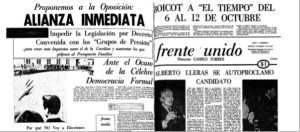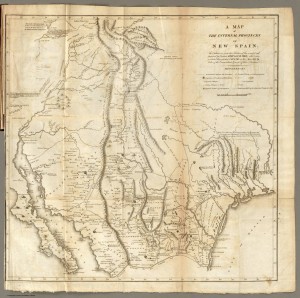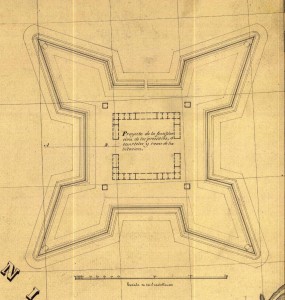By Gustavo Quintero
On February 15, 1966, the Colombian army shot a Catholic priest named Camilo Torres while he was trying to take a rifle away from a soldier he had just killed. The priest’s dead body is still missing. Conflicting versions about his burial site continue to emerge fifty years after the episode. Some say his body was confiscated by officials to prevent the formation of a cult around his grave and was buried in a municipal cemetery in Bucaramanga, Capital of Santander state. But, in January 25, 2016, his remains were exhumed and, shortly after, official reports denied that they belonged to Camilo Torres. Now, for different reasons, Torres life and death have not been forgotten. He is widely known among Colombian left-wing political groups and student circles, and he is a necessary reference in edited volumes about Marxism in Latin America. Camilo Torres has become a symbol of armed resistance against the State. His name is a synonym of the revolutionary soldier that fights until the last consequences.

Born in 1929, son of an upper middle class family from Bogotá, Colombia, Torres was ordained as a priest when he was 25, and shortly after, he flew to Leuven, Belgium, to study sociology. By 1960, he had come back to Colombia and co-founded the first department of sociology in the country, at the National University. In 1964, the Colombian Episcopate accused Torres of being a communist because of his constant clashes with the Church’s conservative political positions and because he was seen as the man responsible for a series of student protests in Bogotá, and so was forced to renounce to his ministerial orders. Around the same time, Torres initiated a political coalition intended to boycott the 1965 presidential elections. By November 1965, he joined the ELN left wing guerrilla movement; it was during his first combat in 1966 that the Colombian army killed him.
Torres was trying to mobilize against a government made by a two-party regime known as the National Front (El Frente Nacional). In 1958, the political elite made a pact in Benidorm –a small town in Spain under Franco’s regime– in which they agreed to share the State power between the Liberals and the Conservatives. This was a way for the landowners, businessmen, and traditional elite to legitimize the status quo by alternating the presidency and splitting the major political positions. Hence, it was practically impossible for political minorities –such as the left parties– to achieve any governmental representation.
In 2016, fifty years after Camilo Torres’ death, Colombia is on the verge of a historical moment: since 2012, the Colombian government and the FARC, the largest guerrilla group in the country, discussed in Havana, Cuba, a peace treaty that could put an end to one of the oldest conflicts in the hemisphere. They reached an agreement in the past month, and it’s up to the Colombian citizens to support or reject the deal, by voting on a referendum to be held on October the 2nd.
The ELN, which Torres was a part of, will remain the only small left-wing guerrilla group in Colombia. Although the rebels have secretly met with the Government to start peace negotiations, both parties have not yet reached an initial agreement.
Can one consider Camilo Torres more than a character among the long-standing queue of martyrs of revolutions past, and give him the opportunity to say something to our present? Can one offer Camilo Torres the possibility to participate, albeit from the distance of time, in the Colombian political arena by listening to the echoes of his multiple attempts to organize the people into a movement that could have reshaped Colombian democracy from within?
Torres still resonates today because of that gesture: Before joining the ELN frontlines, Camilo Torres organized a political movement known as El Frente Unido. For seven months, from the end of April to October 1965, he coordinated a series of meetings with the unions of the most powerful companies in Colombia (Coltabaco, Bavaria, and Coltejer). He organized popular gatherings in public spaces and pacific demonstrations in several cities of Colombia. He published a newspaper called frente unido (he insisted on not using capitalized letters), which was printed weekly and was widely distributed in the cities as well as in the countryside. He wanted to send a message to the Colombian Population: the people need to collectively organize and assert a more direct form of democracy in which they can have more participatory means to engage in decision-making processes. Facing the stationary two-party system established by the United Front, Camilo Torres popular movement aimed to creatively reshape Colombian politics to have a more substantial democracy, not only a formal democratic regime. For members of the movement, the question was how to delegitimize the presidential elections of 1965. They didn’t want to form an armed group to seize power but instead to reach an unprecedented level of voter abstention.
For El Frente Unido the stakes were high: its force rested upon the assumption that Colombian democracy could be reformed from within, that masses of citizens could assert their will by engaging in popular demonstrations and by rendering visible their unfulfilled demands.

As a way of revealing the large-scale discontent of the Colombian population, El Frente Unido’s aim was to antagonize and resist such a limited democracy. Torres insisted that his political group was a bottom-up organization that refused to become a traditional party. Through his speeches and the texts he wrote for the newspaper frente unido, he asserted the need for the people to unite, leaving aside any possible cause for division and exclusion.[1] His interventions were a call to join a collective force of interruption of the status-quo: it did not matter whether an individual was rich or poor or whether she had religious beliefs. What counted was the willingness to establish a more participatory democratic system. In other words, El Frente Unido was an instance of convergence where a multiplicity of groups congregated because of the frustrations towards the established political order, and because of their readiness to participate in a collective action intended to make a radical change in the Colombian sociopolitical structure. El Frente Unido articulated a myriad of hopes in future change into a force to resist and reshape the Colombian political system from the inside and without having to call for an armed struggle. The movement was anti-nothing, but the objective was to change everything.[2]
The impact of the group became manifest through collective acts of resistance in everyday practices. For example, to make themselves be heard, they coordinated efforts to boycott one of the main newspapers in Colombia, El Tiempo: from October the 6th to the 12th 1965, anyone associated with El Frente Unido, refused to buy the newspaper. This act, Torres declared, was much more useful than throwing rocks at any important building.[3] Such gestures became so widespread that they succeeded in drawing national attention: Gustavo Rojas Pinilla, one of the presidential candidates for the 1965 elections (and former head of the State in a military government) offered Torres the position of Cardinal, and even ambassador in Paris, if only he would declare that the elections were free and fair. Such was the magnitude of the movement: it became a worthy opponent of the elites by engaging in collective everyday action.

The momentum arrived at a sudden halt when, after receiving several death threats and having to deal with constant acts of sabotage from within El Frente Unido, Camilo Torres made the decision to enter the armed struggle by enlisting in the ELN lines. In doing that, not only did he discredit El Frente Unido as a non-violent political group, but he also allowed for the ELN to use his name and image as an emblem to pursue the ongoing war against the State.
The perspective of approaching Camilo Torres’ revolutionary endeavor via a non-armed struggle seems contentious, since he is remembered as “el cura guerrillero” (the guerrilla priest). But, as a fifty-two-year war that has left countless of victims is arriving to a major turning point, former armed revolutionaries will now have to find new ways to antagonize and disagree with the traditional political elite in Colombia without violence. Indeed, as history has shown us: overt violence against the State has long-term traumatizing effects on the civil population.
The experience of Torres also makes visible the need to have guarantees for engaging in the political arena (without receiving death threats, or having to deal with the extinction of an entire new political party). Therefore, as we approach an uncertain future, looking back to trace creative modes to expand the democratic means of participation seems more pressing than ever. Hope remains, and in this case is a mode of resisting the assumption that history in Colombia irredeemably repeats itself, spiraling towards oblivion. If Torres were here today, perhaps he would give one last speech to say: “We need to unite in those points that we all have in common, to look for the wellbeing of the majority of the Colombian people, without any prejudice, with arms wide open, in favor of all Colombians.”[4]
For further reference:
Broderick, Joe. Camilo: el cura guerrillero. Bogotá, Colombia: Editorial El Labrador, 1987.
Fundación colectivo Frente Unido. Frente Unido: Unidad en la diversidad. Bogotá, Colombia: Ediciones Desde Abajo, 2014.
Guzmán Germán. El padre Camilo Torres. México: Siglo Veintiuno Editores, 1968.
Löwy Michael, Marxism in Latin America From 1909 to the Present: an Anthology. Atlantic Highlands, N.J: Humanities Press, 1992.
Löwy, Michael. The War of Gods: Religion and Politics in Latin America. New York: Verso, 1996.
Liss, Sheldon, Marxist Thought in Latin America. Berkeley: University of California Press, 1984.
Sánchez Lopera, Alejandro, “Ciencia, Revolución y creencia en Camilo Torres: ¿una Colombia Secular?”. Revista nómadas. 25. Universidad Central de Colombia 2006. 241-258.
Torres, Camilo. Cristianismo y Revolución. México Ediciones Era. 1970.
Notes:
[1] Torres, Camilo: Cristianismo y Revolución, 451
[2] Torres, Camilo: Cristianismo y Revolución, 486
[3] Torres, Camilo: Cristianismo y Revolución, 511
[4] Torres, Camilo. Cristianismo y Revolución, 468.
Gustavo Quintero is a PhD student in the Department of Romance Studies at Cornell University.
Email: gaq5@cornell.edu



